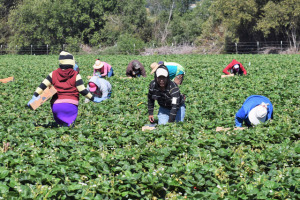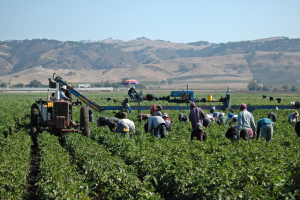2012 Farm Bill Priorities
June 30, 2011 Michael R. DimockTestimony before the State Board of Food and Agriculture
Regarding 2012 Farm Bill Priorities
Sacramento, CA
Good morning Madam Secretary, President McNamara and Members of the Board. Thank you for inviting me here today to share with you the views of Roots of Change regarding priorities for the 2012 Farm Bill.
As you know our mission is creation of a sustainable food and agriculture system in the State of California by the year 2030, which is just 19 years away, less than one generation. That is a tall order given the complexities and the glaring fact that we actually don’t know all the science we need to know in order to act sustainably and that actual confirmation will require centuries, not decades. But what we can do, despite the complexities, is to enlarge the set of values underlying agriculture and food systems, normalize deep systemic thinking for those who are designing, managing and regulating food and agriculture, and we can establish a cultural norm that measures progress using indicators designed to ensure a supply of healthy food for all, a completely functional and resilient resource base from which that food is derived, and a food and framing workforce in which there is commitment to rapid and perpetual improvement because there is sufficient wealth and deep satisfaction to be gained by all involved from the fields to restaurant tables.
The Farm Bill is one pivotal element of many that must be altered in order to create the conditions for a sustainable food and agriculture system to emerge. The current farm bill, born early in the 20th Century and updated to meet perceived needs since then, is primarily designed for one purpose: to make available to the American people low cost food. We have done this using the Nutrition, Commodity, and Risk Management titles that account for close to 90% of the Farm Bill.
In the 21st Century, the Farm Bill must be designed to optimize the health and resilience of the nation and her people. Healthy food comes from healthy farms and ranches and food manufactures that are thinking about nutrition first. It comes from a healthy resource base free of disease and toxins. Health and resilience must become the guideposts for setting policy priorities. The two questions in our minds at Roots of Change are
- is the current framework of titles still appropriate for delivery of health and resilience?
- if not, how do we get from the existing framework to a new framework within current political and process realities?
One way to think about this is to ask whether the new USDA symbol for healthy eating, My Plate, can result from the spending programs within the Bill. My Plate clarifies that about 70% our diet should be a variety of fruits, vegetables, and grains. Half the grains should be whole, not processed. The 30% of plate dedicated to protein should come from lean meats and calcium rich diary products. Looked at this way, the Farm Bill is not aligned or appropriate.
We are spending most of the money within Commodity, Conservation and Insurance programs in the Mid West to make meat and processed food available at low prices for SNAP recipients who disproportionately suffer from diabetes and other diet related disease. My rough estimate is that we are spending close to $100 billion per year to support the priorities that no longer meet the nation’s primary needs. The clearest example is that we spend over $5 billion on direct payments to commodity crops each year, the vast majority of which become animal feed or processed food products found in the middle aisles of the grocery store, compared to $55 million for specialty crops. The crop insurance and loan programs, regulatory regimes and the resulting lobbying system in Washington are all focused on 20th Century goals. This stark reality would suggest that a complete rethink of the American food and farm policy is required. So, before I get into specific recommendations that will comfortably fit within the current farm bill title framework, I want to ask this board to make a bold move.
I encourage you to have a look at the six Seattle Farm Bill Principles that are gaining steam among many of us thinking long-term about the future of food and farming. They call for
- A health-centered food system
- Sustainable agriculture practices
- Community and regional prosperity
- Equitable access to healthy food
- Social justice and equity
- A systems approach to policy making
I think it is would a great service to the nation for California to ask the people of Washington and Oregon to join us in raising up these principles together and to ask USDA, Congress and the President to form a special commission that undertakes a fundamental rethink of farm and food policy using these six principles. The goal would be to offer a draft bill by 2016. I am happy to discuss this concept at another date.
Within the current context, here is our list of priorities for the coming farm bill debate:
1) Specialty Crop Funding should be increased to $90 million annual mandatory authorization and include language for infrastructure that provides nutrition incentives for direct marketing farmers, this would all be through the Agricultural Marketing Service programs. Currently, the funding in the base line is $55 million provided to the states, with California the largest beneficiary. Last September, NASDA’s Annual Meeting passed a Resolution on Specialty Crops and Nutrition Incentives, with strong support from former Secretary AG Kawamura.
We are grateful that CDFA took a lead in the drafting and passage of this Resolution. Given the many positive programs originating in the states over a wide range of programs for specialty crops, an increase to $90 million would have many benefits, more so with report language that projects to promote access to specialty crops by SNAP clients to improve health and reduce diabetes and obesity. The source of extra funds could be re-allocation from direct payments, which are widely seen as ending in the next bill.
2) SNAP-Education funds should be raised 10% for incentives, which would mean about $37.5 million per year that would be available for innovative nutrition incentive expenditures by farmers who direct market. Farmers markets should receive 100% reimbursement for farmers markets. SNAP Outreach regulations should be simplified to allow SNAP to increase outreach at farmers markets and to enable successful SNAP Outreach programs run by farmers markets be fully reimbursed rather, than the current 50% reimbursement rate.
3) We support SNAP Nutrition Incentives based on the State Board’s Resolution passed in April when Gus Schumacher was here before you. We concur that 1% of the SNAP funds should be used to provide nutrition incentives for the purchase of local and regionally grown healthy fruits and vegetables at farmers markets, CSA’s and roadside stands. This means Congress would need to provide language that directs the Food and Nutrition Service to implement this goal. And as you know, ROC, Wholesome Wave, Fair Food Network, Market Umbrella, and others are working with dozens of local partners, such as Frank Tamborello and Hunger Action LA, around the country to prove the concept and impact of nutrition incentives. Our initial data will become available early next year for you and the Congress to consider.
4) The Farmers Market Promotion Program should be fully re-authorized at $10 million annually through the Agriculture Marketing Service. With some 5,000 farmers in California marketing at over 550 farmers markets, re-authorizing mandatory funding at $10 million for the Farmers Market Promotion Program would be a modest investment with very high economic returns. Re-allocation of the saving from direct payments could easily cover this annual investment.
5) The Senior Farmers Market Nutrition Program should be raised from $22 million annual mandatory funding through the Agriculture Marketing Service to $35 million, which could mean over $3 million per year coming to California.
At the current funding levels, the program benefits nearly 50,000 seniors in California. They exchange their vouchers at 435 farmers markets with 1,100 farmers receiving in increase in revenue of $850,000 annually. Nationally, some 20,000 farmers receive $22 million at 4,600 farmers markets, 3,681 roadside stands and 161 CSA’s. It’s operational in some 46 states. From a California perspective, an increase in federal support to $35 million with 10 percent of the total coming to California would have significant nutritional and revenue impact on markets, stands and CSA’s. It would also encourage more low-income seniors to sign up for SNAP, where only 30 percent currently participate.
6) Due to time constraints, and my hope that you will ask others solely focused on conservation and the environment, I will not go into detail, but I will say this. Conservation programs must be fought for and retained. It would be a huge failure in national leadership to eliminate or even reduce conservation funding. I ask you to look carefully at the work of American Farmland Trust, which is offering innovative approaches for transforming current commodity programs into systems that support conservation across multiple scales of farms.
7) Research is also very important. Given the challenges of climate change, energy prices, and population growth, research may be more important than ever. I took the time early this morning to read the USDA 2011 Budget Summary and Performance Plan. It was very enlightening because it reveals how the current USDA and Administration are trying to work within the existing policy framework to reorient how and why we produce food and manage farms. One of the best examples is the use of cross agency working groups that allow the USDA to break out of its silos and work from a more systemic and holistic perspective. This is to be commended. Another important and impressive activity is the reprioritization of research. We thus end our recommendations by asking that CDFA and California fight to keep the research programs of NIFA and ARS intact so that resource stewardship, organic farming, product innovation, crop and livestock protection will continue to evolve and improve. Funding should be kept at the current levels, which in my view are still too low.
Roots of Change looks forward to working with you on these and other priorities that emerge from your work.



